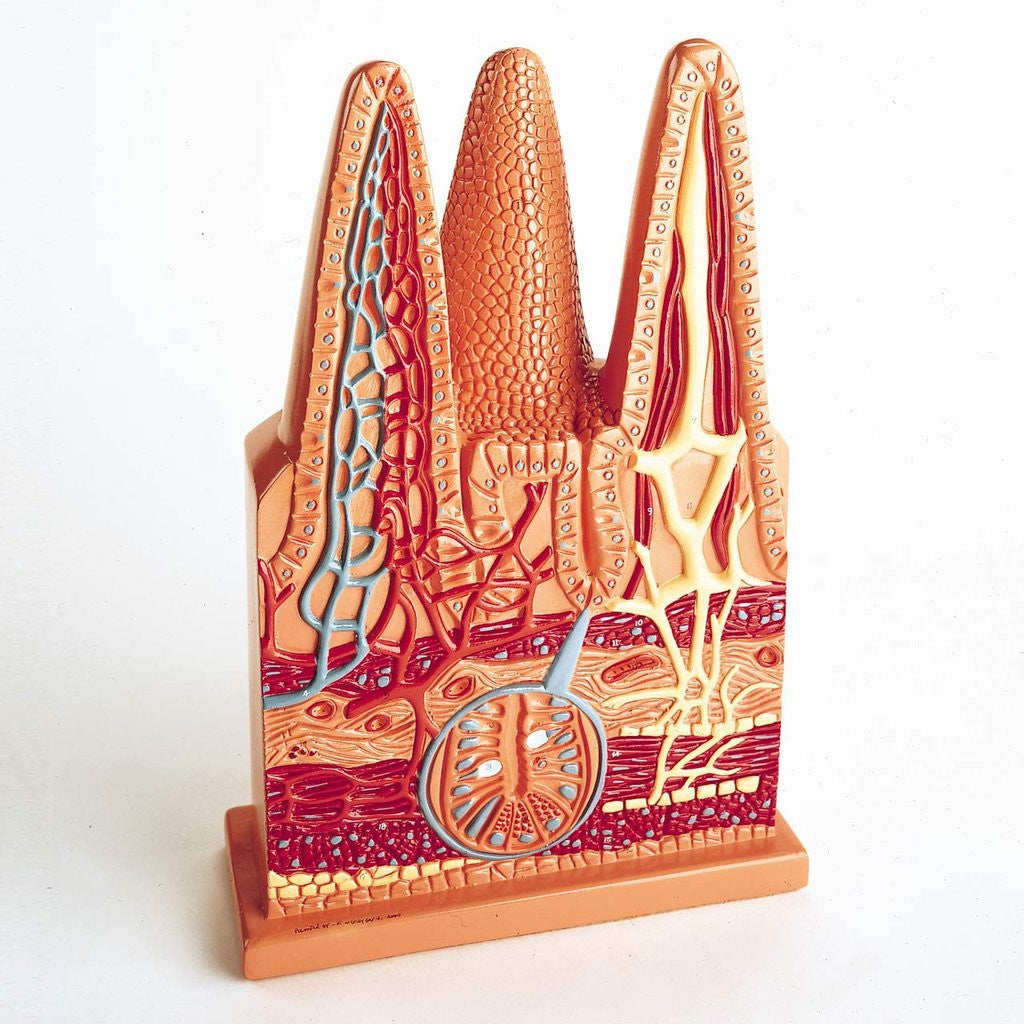Description
Magnified hundreds of times, three of the more than 5 million villi that line the small intestine are replicated in this vinyl model depicting their essential role in digestion and nutrient absorption.
The Denoyer-Geppert Intestinal Villi model accurately represents three of the five million villi that line the walls of the 27-foot small intestine in humans.
Villi exist to increase the surface area available for food absorption; this area has been estimated at approximately eleven square yards. Also, under some conditions, food may pass through the small intestine rapidly; the villi make the most of the time that the digested material is in contact with the intestine.
The intestinal villi (1) project from the surface of the mucous membrane over the folds and between them. They have cores of lamina propria (8), which is composed of loose connective tissue. Each villus contains a vascular capillary network (3), a central lacteal (7), and nerve fibers.
Lymphatic tissue abounds in the lamina propria and may appear as solitary nodules or in groups of nodules called Peyer’s patches. The flow of lymph is controlled by valves so it can pass out of the intestine only. This lymphatic system makes up one of the two important routes that absorbed particles travel to enter the blood stream.
The second consists of the vascular system; here, one arteriole (5) enters each villus splitting into capillaries and is collected by venules (4).
The crypts of Lieberkühn (6) open between the villi. They produce enzymes, mucus and possibly a hormone. There are goblet cells (21) in the crypts among the columnar epithelium (20). Goblet cells may also be found in the epithelium (2) in the villi. At the bottom of the crypts, the
Paneth cells (22) may be located; although there are several theories their function is unknown
at the present time. They are special cells that contain zinc.
The muscularis mucosae (10, 11) possess no distinguishing characteristics. The muscularis consists of an inner circular (10) and outer longitudinal layer (11), and it thins out as it approaches the large intestine.
The submucosa (13) distinguishes the blood and lymph vessels. The serosa (16) is composed of visceral peritoneum. Efferent nerve fibers from Auerbach’s plexus (18) are muscle-oriented and Meissner’s plexus (19) are submucosa-oriented. Between them, they serve the smooth muscle of the intestinal wall. The visceral afferent nerves conduct the impulses from the intestine to the central nervous system.
Complete absorption into the blood stream is a complex biochemical process. Briefly, the simple sugars, minerals, amino acids, vitamins, and some glycerol pass through the epithelial cells (2) of the villi into the capillaries (3).
The lymph vessels (7) in the villi receive the products of fat digestion and transport them through the mucosal cells into the lymph. Not all fats are absorbed at equal rates or to an equal degree. Generally, the soft fats and oils are absorbed readily while the hard fats with melting points above body temperature are less completely absorbed.
- Villus
- Intestinal Epithelium
- Capillary Network
- Venule
- Arteriole
- Crypt of Lieberkuhn
- Central Lacteal
- Lamina Propria
- Muscle Fibers
- Circular Muscle Layer
- Longitudinal Muscle Layer
- Arteriole cross-section (Red blood corpuscles in lumen)
- Submucosa
- Circular Muscle Layer
- Longitudinal Muscle Layer
- Serosa
- Adipose Tissue (fat)
- Auerbach’s Nerve Plexus
- Meissner’s Nerve Plexus
- Columnar Epithelium (with striated border)
- Goblet Cell
- Paneth Cell
- Lymphocyte
